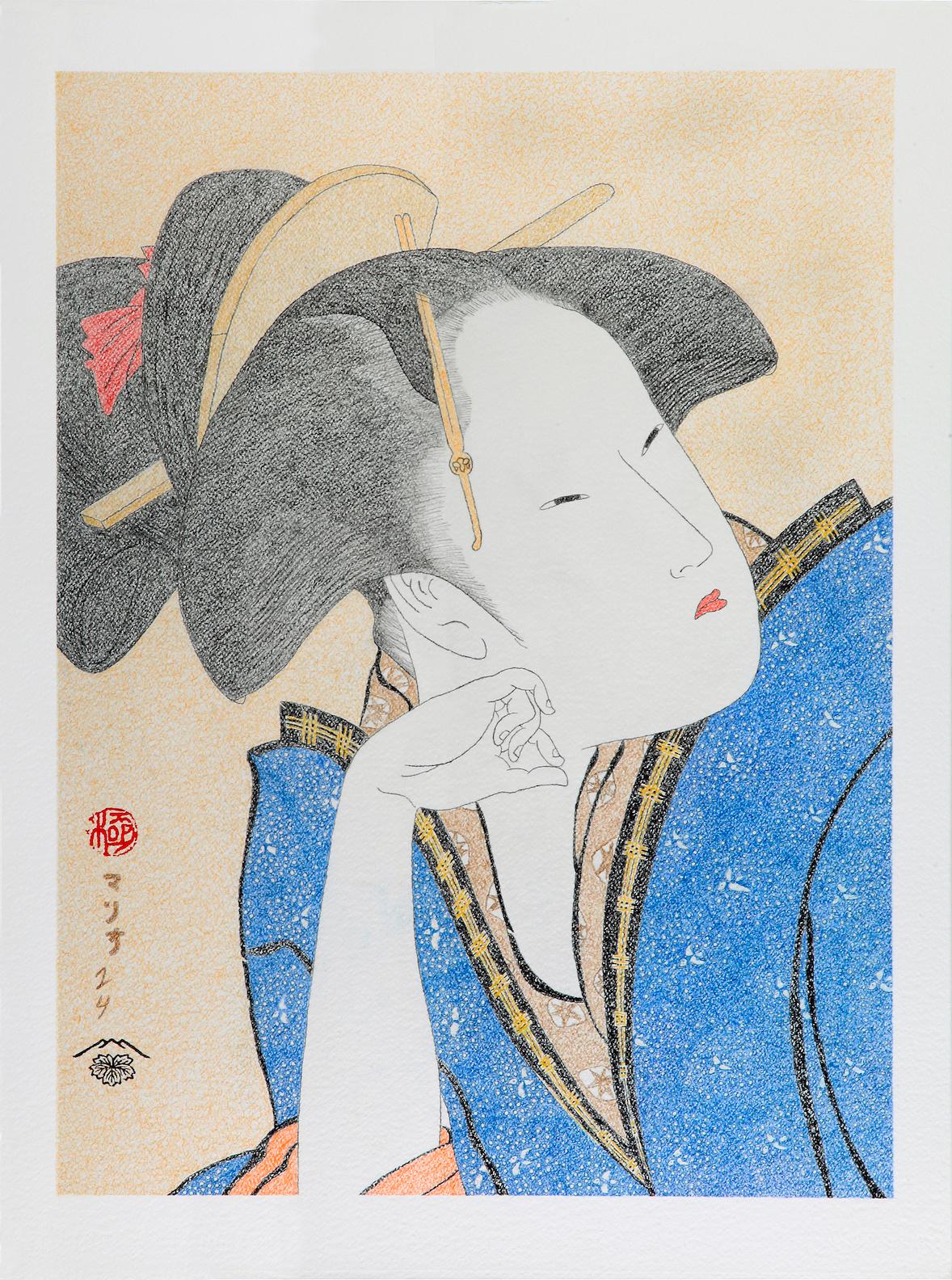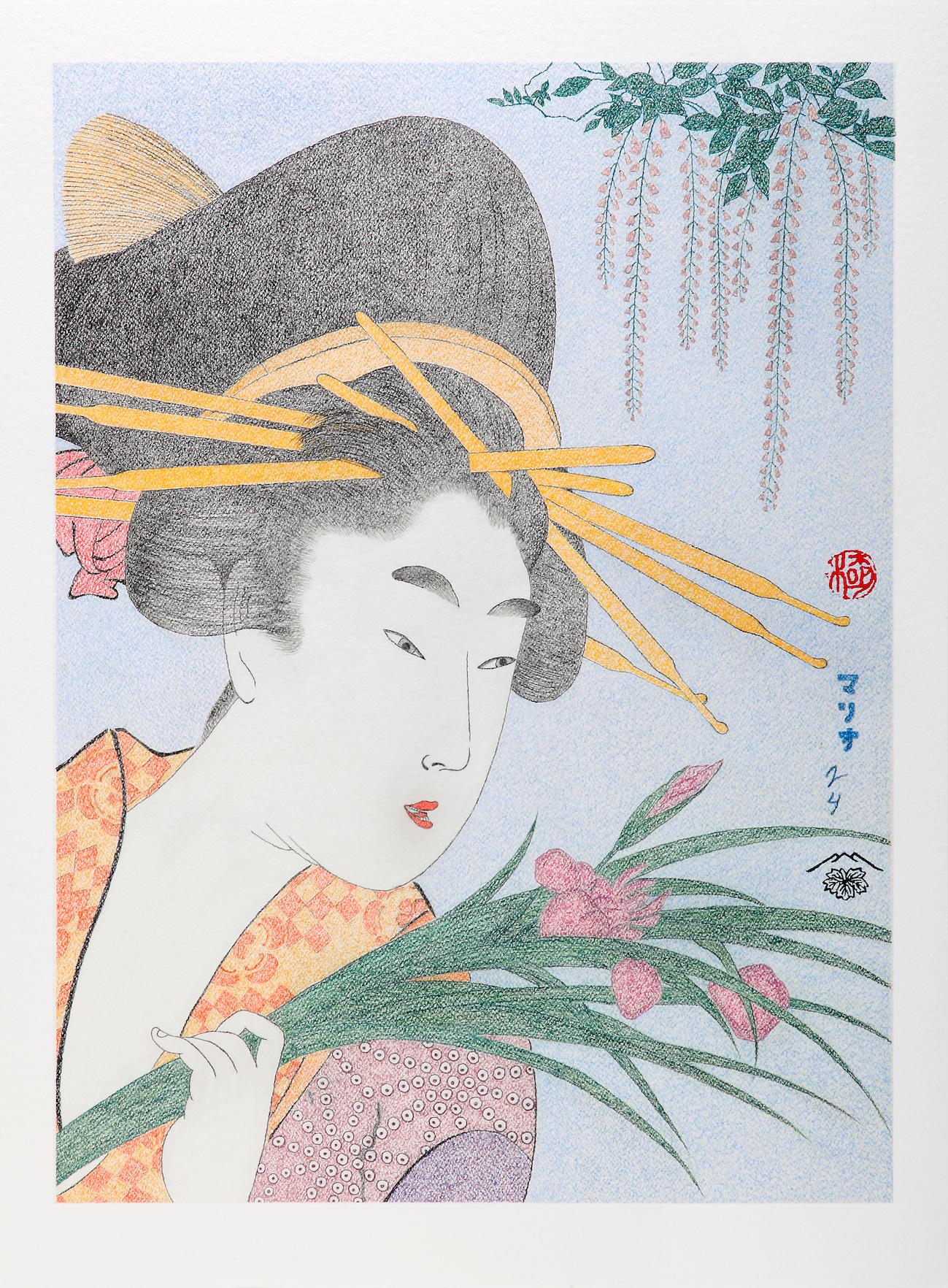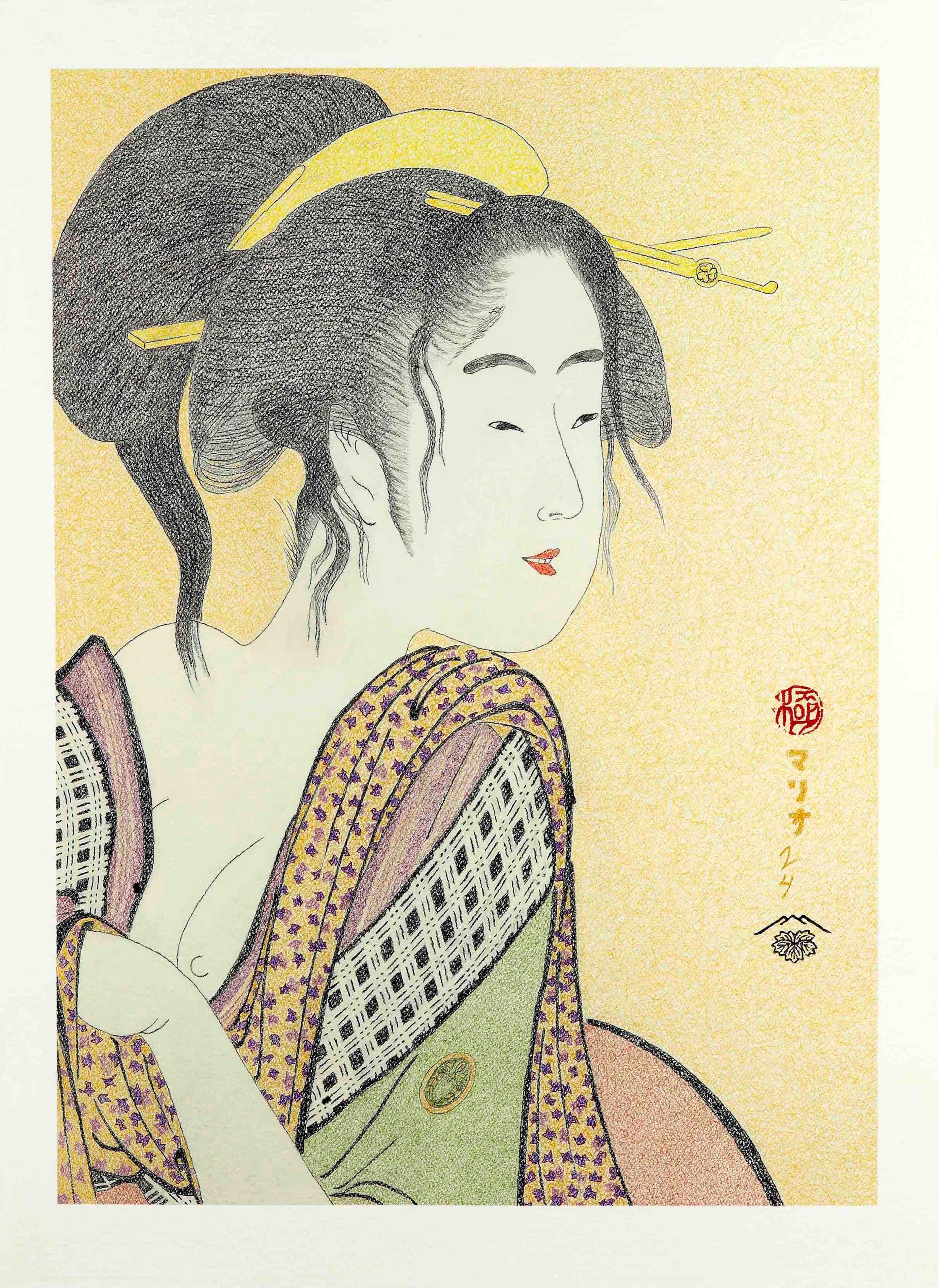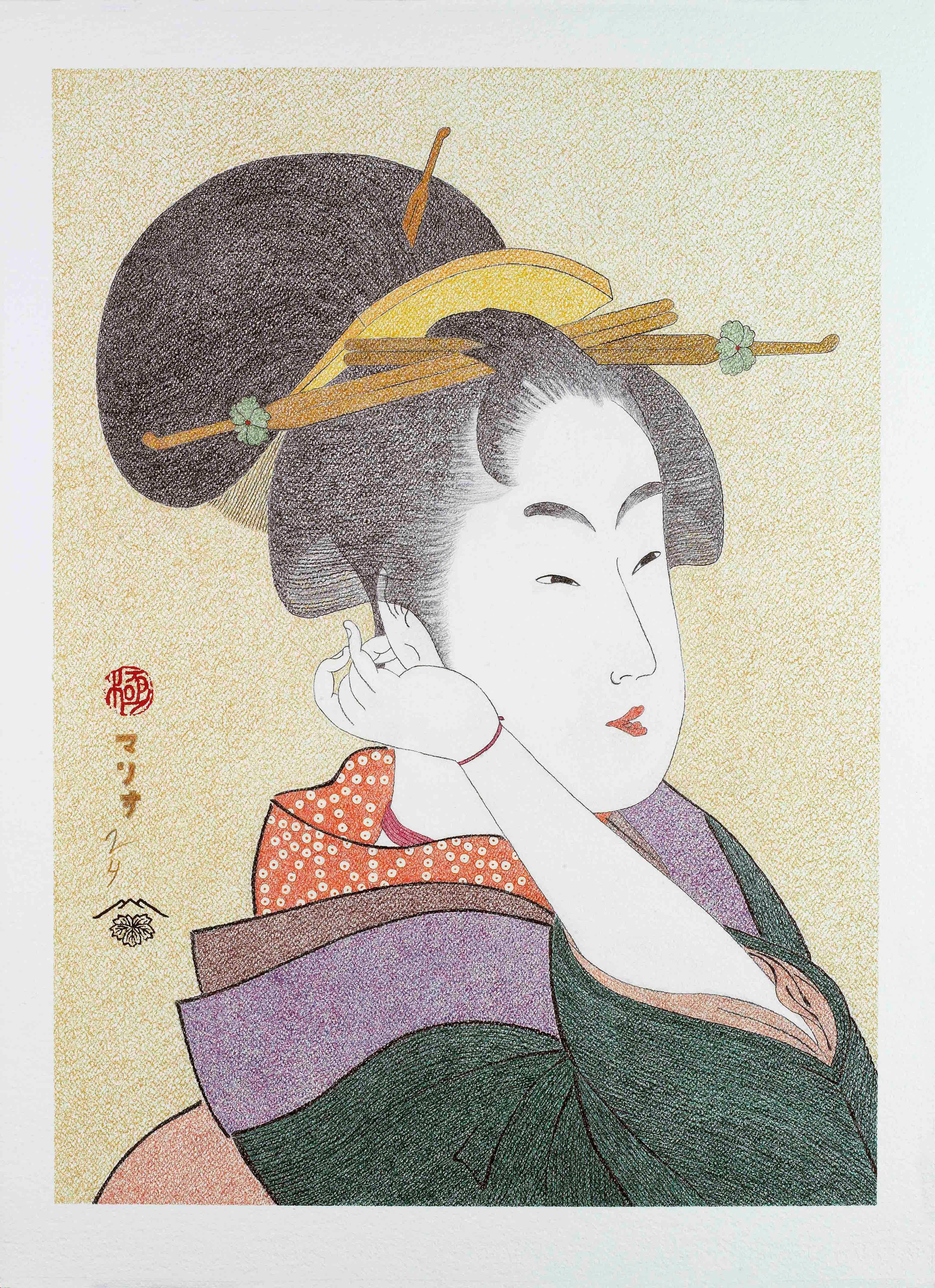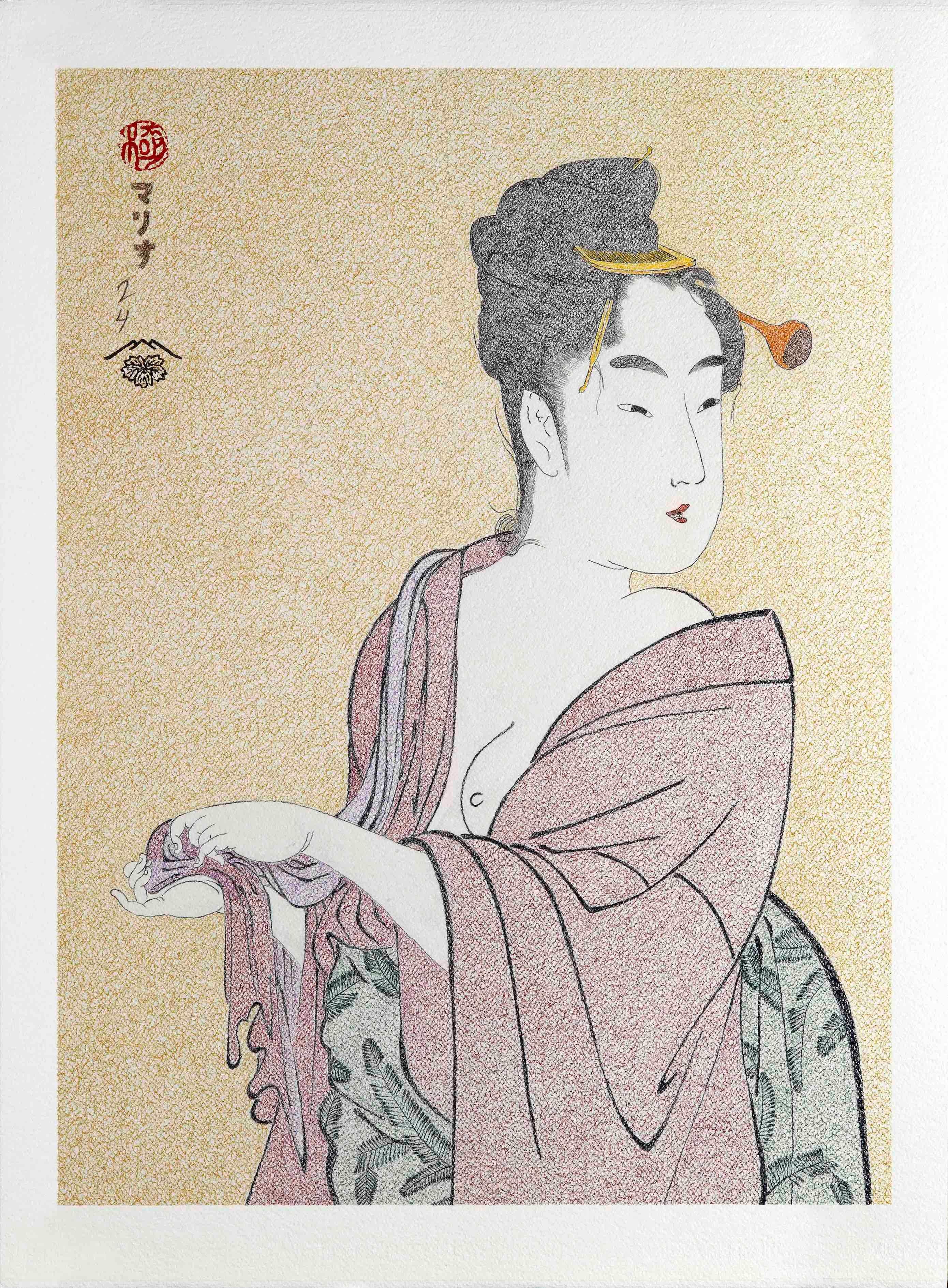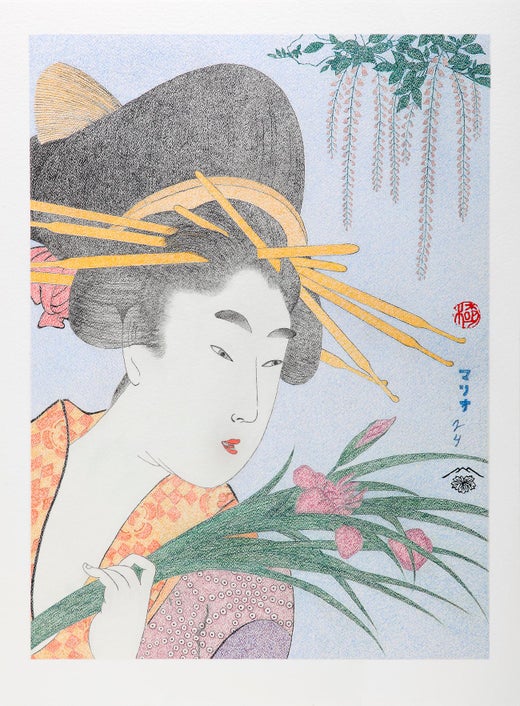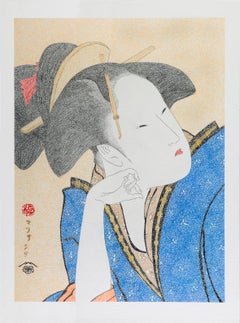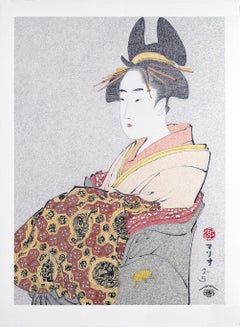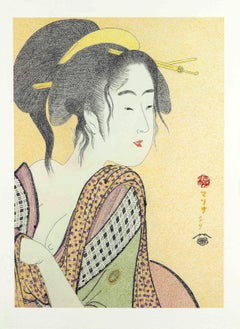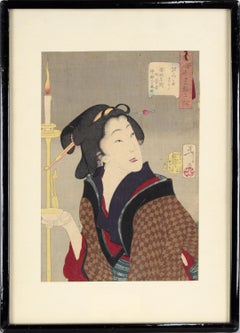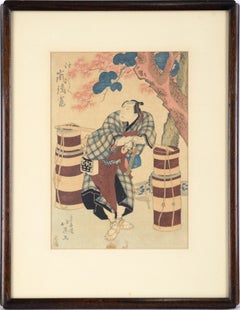Items Similar to Japanese Art Figurative Painting, Love for a street-walker, Edo period
Want more images or videos?
Request additional images or videos from the seller
1 of 8
Mario B. GilJapanese Art Figurative Painting, Love for a street-walker, Edo period2014
2014
$2,623.93
£1,952.99
€2,190
CA$3,594.13
A$3,997.46
CHF 2,087.35
MX$48,644.86
NOK 26,658.65
SEK 25,001.11
DKK 16,671.71
Shipping
Retrieving quote...The 1stDibs Promise:
Authenticity Guarantee,
Money-Back Guarantee,
24-Hour Cancellation
About the Item
LOVE FOR A STREET-WALKER
Crayon, graphite, pencil on paper.
Measurements: (H) 76 x (W) 56 cm.
Attractive portrait of an Edo prostitute hurrying through the streets. She wears a black kimono over layers of colored kimono, tucking her hand into the "obi" at her waist. A white scarf is draped over her head, the edge caught between her teeth, and loose wisps of hair framed her face. There is an impressive contrast between the black kimono and the yellow-orange of collars, sleeves and "obi", balancing the composition the pastel pink of the scarf that covers her head.
This image is part of the "bijin-ga" series, Pretty Women, drawn by Mario BGil, based in the Kitigawa Utamaro woodblock print "Love for a street-walker" (1795), 37,2 x 24,6 cm. The British Musem. London, UK.
The artist reproduces the seal of the censor (Kiwame) and from the original publisher ("Tsutaya", climbing leaf)), between the two, the signature of Mario BGil written in Japanese, with the date 14 (2014).
The mesaurements of the drawing are 76 x 56 cm. (29,92 x 22,05 in.), with a painted surface of 67 x 49,5 cm.
With his work on the "bijing-ga" series, Mario BGil wanted to embellish, give brilliance and volume to the images presented by japanese artist Kitigawa Utamaro in those beautiful engravings, ennobled with the patina of time, which have served as inspiration. The result obtained is almost life-size portraits, endowed with strong chromaticism and valuable contrasts, all enhanced, in turn, with the volume provided by the weight and rigidity of the paper, and its thick texture (Fabriano Artistico “grana grosso”, 640g/m2; the thickness and hardness of the paper makes it necessary to transport it without rolling).
In this way, Mario BGil pays tribute to his admired artist and offers us a new and enriched vision of this popular facet of oriental art from the 18th and 19th centuries.
ABOUT THE ARTIST
Mario BGil is a self-taught artist who for years has combined his creative activity with his work in the family business, away from commercial art galleries. In 2012, a deep interest in oriental art was awakened in him and he began to study the great masters of Japanese Ukiyo-e prints, who had such an influence on the European avant-garde of the late 19th century.
The discovery of Kitagawa Utamaro (1753-1806), a key figure in the metropolitan culture of Edo (now Tokyo), and a point of reference in the history of Japanese engraving, meant for Mario a change of course caused by the imperative need to study his images, recreate them and recreate himself in them, incorporating certain changes in both the format and the technique used.
The technique used by MBG is very different from that used in engravings with wooden blocks impregnated in inks of intense colors that serve as a model. On a paper of heavy weight and thick texture, Mario BGil outlines with a black pencil, and colors the spaces with pencils and watercolors. Faced with the intensity of color of the prints (already very lost in some of them due to their age and exposure to the sun), their drawings are sifted by the streaky white, due to the thick texture of the paper, showing more lines, soft and warmer tones, giving color to the backgrounds but leaving all the volumes corresponding to the skin blank, thus giving the figures a classic serenity that transcends their oriental character.
Between 2014 and 2015, Mario BGil made more than 35 drawings based on the prints selected from the huge amount of work produced by the master Utamaro that shows images of courtesans in different attitudes and poses that highlight the subtle delicacy of oriental feminine beauty.
Kitagawa Utamaro was a faithful representative of the tastes of the Japanese bourgeoisie of its time, which had transformed the life of the cities giving birth to a culture parallel to the official and aristocratic.
The activity of the new rising group took place in special neighborhoods of Edo (Tokyo) and Osaka and its banality, inconsistency and frivolity earned it the name of Ukiyo: "floating world"; a world that will give priority to a series of cultural manifestations much more popular and less intellectualized than those preferred by the nobility. The new neighborhoods are filled with brothels and shows that the upper classes will consider vain, and a new breed of heroes: sumo wrestlers, singers, actors and courtesans will come to reign in this "floating world."
In front of the traditional painting the stamp arises with images of this new world. The courtesans of the pleasure districts of Edo that Utamaro portrays, do not always appear perfectly dressed to receive the client, but are surprised while getting ready, or during the day. He observes them without being seen, spy on them in their daily and intimate work. All of them are women drawn in a similar style, with elongated faces, straight delicate noses (almost a single line) and other features reduced to a mere suggestion (the mouth, a tiny butterfly of red).
The importance that it has had in later European artists (Degas, Toulouse-Lautrec, Bonnard, Gauguin, Van Gogh ...) has been great and Mario BGil has not been able to escape the recreation of those images so classic and, at the same time, so current, paying clear tribute to its original creator.
BIOGRAPHY Mario BGil is a self-taught artist who for years has combined his creative activity with his work in the business world, away from commercial art galleries. Man of very diverse interests and great artistic sensitivity, studied Art History and in 2012, a deep interest in oriental art was awakened in him so that he began to study the great masters of Japanese Ukiyo-e prints, who had such an influence on the European avant-garde of the late 19th century. The discovery of Kitagawa Utamaro (1753-1806), a key figure in the metropolitan culture of Edo (now Tokyo), and a point of reference in the history of Japanese engraving, meant for Mario a change of course caused by the imperative need to study his images, recreate them and recreate himself in them, incorporating certain changes in both the format and the technique used. The technique used by MBG is very different from that used in engravings with wooden blocks impregnated in inks of intense colors that serve as a model. On a paper of heavy weight and thick texture, Mario BGil outlines with a black pencil, and colors the spaces with pencils and watercolors. Faced with the intensity of color of the prints (already very lost in some of them due to their age and exposure to the sun), their drawings are sifted by the streaky white, due to the thick texture of the paper, showing more lines, soft and warmer tones, giving color to the backgrounds but leaving all the volumes corresponding to the skin blank, thus giving the figures a classic serenity that transcends their oriental character. Between 2014 and 2015, Mario BGil made more than 35 drawings based on the prints selected from the huge amount of work produced by the master Utamaro that shows images of courtesans in different attitudes and poses that highlight the subtle delicacy of oriental feminine beauty. Kitagawa Utamaro was a faithful representative of the tastes of the Japanese bourgeoisie of its time, which had transformed the life of the cities giving birth to a culture parallel to the official and aristocratic. In front of the traditional painting, the stamp arises with images of this new world. The courtesans of the pleasure districts of Edo that Utamaro portrays, do not always appear perfectly dressed to receive the client but are surprised while getting ready, or during the day. He observes them without being seen, and spies on them in their daily and intimate work. All of them are women drawn in a similar style, with elongated faces, straight delicate noses (almost a single line), and other features reduced to a mere suggestion (the mouth, a tiny butterfly of red). The importance that it has had in later European artists (Degas, Toulouse-Lautrec, Bonnard, Gauguin, Van Gogh ...) has been great and Mario BGil has not been able to escape the recreation of those images so classic and, at the same time, so current, paying clear tribute to its original creator.
About the Seller
5.0
Vetted Professional Seller
Every seller passes strict standards for authenticity and reliability
Established in 2002
1stDibs seller since 2017
67 sales on 1stDibs
Typical response time: 1 hour
- ShippingRetrieving quote...Shipping from: Bilbao, Spain
- Return Policy
Authenticity Guarantee
In the unlikely event there’s an issue with an item’s authenticity, contact us within 1 year for a full refund. DetailsMoney-Back Guarantee
If your item is not as described, is damaged in transit, or does not arrive, contact us within 7 days for a full refund. Details24-Hour Cancellation
You have a 24-hour grace period in which to reconsider your purchase, with no questions asked.Vetted Professional Sellers
Our world-class sellers must adhere to strict standards for service and quality, maintaining the integrity of our listings.Price-Match Guarantee
If you find that a seller listed the same item for a lower price elsewhere, we’ll match it.Trusted Global Delivery
Our best-in-class carrier network provides specialized shipping options worldwide, including custom delivery.More From This Seller
View AllJapanese Art Ukiyo-e Figurative painting, Reflective Love, Edo period
Located in Segovia, ES
Bijing-Ga Series XII (Nº 12)
Title: Reflective Love.
Lovely portrait of a beauty looking over her shoulder.
In Reflective Love (from the Utamaro...
Category
2010s Edo Figurative Drawings and Watercolors
Materials
Paper, Crayon, Oil Crayon, Graphite
Japanese Art Ukiyo-e Figurative Painting, Hitomoto of the Daimonjiya, Edo period
Located in Segovia, ES
“Hitomoto of The Daimonjiya in Kyô-Machi Itchôme”
Hitomoto holds a bouquet of flowers looking to her left, with a surprised face, and with her mouth aj...
Category
2010s Edo Figurative Drawings and Watercolors
Materials
Paper, Crayon, Oil Crayon, Graphite
Japanese Art Ukiyo-e Figurative Painting, Miyahito of The Ôgiya, Edo Period
Located in Segovia, ES
Bijin-ga Series XXXIV (Nº 34)
Title: Miyahito of the Ôgiya
Three quarter portrait of the elegant courtesan Miyahito of the Ôgiya House. This beautifully dressed japanese woman wears a solid grey outer robe, which contrasts with her soft rose kimono and the colored obi with an intricate geometric pattern. Her hair is arranged high atop her head, adorned with several hairpins. A classic Utamaro beauty print recreated with extraordinary taste and subtlety by Mario BGil in this delicate drawing.
This image is part of the bijin-ga series (“Pretty women”) drawn by Mario BGil, based in the Kitigawa Utamaro woodblock print...
Category
2010s Edo Figurative Drawings and Watercolors
Materials
Paper, Crayon, Oil Crayon, Graphite
Japanese Art Ukiyo-e Figurative painting, Love for a farmer´s wife, Edo period
Located in Segovia, ES
Bijin-ga Series XVII (nº 17)
Title: Love for a farmer´s wife
Sensual portrait of a young and beautiful farmer´s wife. Her cheerful and careless gesture, showing her chest between the open folds of the neckline of his humble dress; the strands of hair falling on her temples, and her smiling gesture denote the state of happiness enjoying love, in a well-deserved break from her hard work.
This image is part of the bijin-ga series (“Pretty women”) drawn by Mario BGil, based in the Kitigawa Utamaro woodblock...
Category
2010s Edo Figurative Drawings and Watercolors
Materials
Paper, Crayon, Oil Crayon, Graphite
Japanese Art Ukiyo-e Figurative Painting, Tatsumi Roko, Edo Period
Located in Segovia, ES
Bijin-ga series XXVIII (Nº 28)
Title: Tatsumi Roko
Portrait of Tatsumi Roko, a geisha of the pleasure quarters in the Edo period. The image belongs to the series Renowed Beauties Likened to the Six Inmortal Poets.
The popular top-class geishas of the day , known as “oiran”, were depicted in this type of print. In ukiyo-e woodblock prints, this close-up portrait view of the upper body is known as an okubi-e (bust portrait).
This image is part of the bijin-ga series (“Pretty women”) drawn by Mario BGil, based in the Kitigawa Utamaro woodblock print...
Category
2010s Edo Figurative Drawings and Watercolors
Materials
Paper, Crayon, Oil Crayon, Graphite
Japanese Art Ukiyo-e Figurative Painting, The fickle type, Edo period
Located in Segovia, ES
Bijing-ga Series XXII (Nº 22)
Title: THE FLICKLE TYPE
Upper half of the body of a woman in yukata (summer kymono) with part of her chest bare. Depicted just after a bath, she is turning her head and drying her hands with the towel hang on her shoulder. Her just-washed hair is tied around an ornate hairpin, the hair style called bai-mage (spiral-shell chignon).
The unkempt hair of the nape and the movement of the hands one on the other are clear examples of Utamaro's mastery, who had an exceptionally observant eye for women.
The Fickle ( or Fancy-free) Type is flirting with more than one member of the opposite sex
This image is part of the bijin-ga series (“Pretty women”) drawn by Mario BGil, based in the Kitigawa Utamaro woodblock print...
Category
2010s Edo Figurative Drawings and Watercolors
Materials
Crayon, Paper, Oil Crayon, Graphite
You May Also Like
"Maiko Kyoto" Japanese Figurative Woodblock Print
By Kiyoshi Saitō
Located in Houston, TX
Kiyoshi Saitō (1907 – 1997) Maiko Kyoto (B) 1959, portrait of a girl facing left, with black and white obi; strong woodgrain texture background. Signature and artist’s seal lower left. Margins are covered with mat board possibly concealing title, date and edition. Visible Area: H 20.75 in. x W 15 in.
Artist Biography:
Kiyoshi Saito was born in Fukushima prefecture in 1907. At the age of five he moved to Otaru in Hokkaido, where he would come to serve as an apprentice to a sign painter. Saito became infatuated with art after studying drawing with Gyokusen Narita and moved to Tokyo in 1932 to study Western-style painting at the Hongo Painting Institute. He began experimenting with woodblock prints and exhibiting his works with Nihon Hanga Kyokai in 1936. Saito mainly worked in oil painting until his invitation from Tadashige Ono...
Category
20th Century Modern Prints and Multiples
Materials
Woodcut
"Thirsty: the appearance of a town geisha in the Ansei era" - Woodblock on Paper
By Tsukioka Yoshitoshi
Located in Soquel, CA
"Thirsty: the appearance of a town geisha in the Ansei era" - Woodblock on Paper
From the series "Thirty-two Aspects of Customs and Manners" (Fuzoku sanjuniso)
Lively woodblock of a...
Category
1880s Edo Figurative Prints
Materials
Paper, Ink, Woodcut
Traditional Japanese Geisha (Kiba II)
By Tatsumi Shimura
Located in Burbank, CA
A beautiful Japanese geisha dressed in a traditional robe shyly claps her hands together. She stands in front of a backdrop of a bamboo screen. This print...
Category
Early 2000s Showa Portrait Prints
Materials
Giclée
$975 Sale Price
50% Off
Actor Arashi Rikan II as Aburaya Yohei - Figurative Woodblock Print on Paper
Located in Soquel, CA
Actor Arashi Rikan II as Aburaya Yohei - Figurative Woodblock Print on Paper
Woodblock print of kabuki actor by Shunbaisai Hokuei (Japanes...
Category
1830s Edo Figurative Prints
Materials
Paper, Ink, Woodcut
Biensennyo-ko Japanese Woodblock Print
By Keisai Eisen
Located in Houston, TX
Japanese Woodblock print of a Biensennyo-ko a powder face women. Behind the women is a framed cityscape. The print is possibly from the series "Eight Favorite Things in the Modern World". The woodblock print is printed on rice paper. The print is not framed.
Artist Biography: Keisai Eisen...
Category
Early 1800s Edo Portrait Prints
Materials
Woodcut
Wistful Love - Screen print after Kitagawa Utamaro - Mid-20th Century
By Kitagawa Utamaro 1
Located in Roma, IT
Wistful Love (Mono-omoi koi) is a beautiful colored print realized after Kitagawa Utamaro, printed in 1956 by Edizioni Beatrice d'Este, a publishing house in Milan.
Screen print on ...
Category
Mid-20th Century Modern Figurative Prints
Materials
Screen
More Ways To Browse
Artist Signature B
Japanese Street Art
Japanese Original Drawing
Edo Period Japanese Art
Japan Engraving
Butterfly Drawing
Line Drawing Of Women
Edo Period Japanese Painting
Japanese Butterfly Art
Wrestlers Painting
Wrestling Painting
Edo Period Woodblock
Two Wrestlers
E Walker
Red Nose
Used Wrestling Figures
Portrait Collar Dress
Kimono Orange
